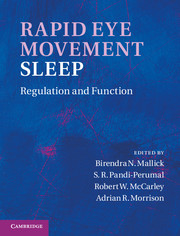Book contents
- Frontmatter
- Contents
- Contributors
- Preface
- Acknowledgments
- Organization
- Section I Historical context
- Section II General biology
- 6 The ontogeny and function(s) of REM sleep
- 7 Evolutionary perspectives on the function of REM sleep
- 8 A systems-level approach to human REM sleep
- 9 REM-sleep regulation: circadian, homeostatic, and non-REM sleep-dependent determinants
- Section III Neuronal regulation
- Section IV Neuroanatomy and neurochemistry
- Section V Functional significance
- Section VI Disturbance in the REM sleep-generating mechanism
- Index
- Plate section
- References
9 - REM-sleep regulation: circadian, homeostatic, and non-REM sleep-dependent determinants
from Section II - General biology
Published online by Cambridge University Press: 07 September 2011
- Frontmatter
- Contents
- Contributors
- Preface
- Acknowledgments
- Organization
- Section I Historical context
- Section II General biology
- 6 The ontogeny and function(s) of REM sleep
- 7 Evolutionary perspectives on the function of REM sleep
- 8 A systems-level approach to human REM sleep
- 9 REM-sleep regulation: circadian, homeostatic, and non-REM sleep-dependent determinants
- Section III Neuronal regulation
- Section IV Neuroanatomy and neurochemistry
- Section V Functional significance
- Section VI Disturbance in the REM sleep-generating mechanism
- Index
- Plate section
- References
Summary
Summary
The amount, timing, and structure of REM sleep are regulated. Three major determinants in REM sleep regulation have been identified: (1) the circadian pacemaker in the suprachiasmatic nucleus (SCN) of the hypothalamus, which through its outputs generates daily cycles in REM sleep propensity; (2) a homeostatic (i.e., need-based) drive for REM sleep that increases in the absence of REM sleep and decreases during its presence; (3) the inhibition of REM sleep by non-REM (NREM) sleep. In humans, the circadian modulation of REM sleep shows a maximum shortly after the nadir of the circadian rhythm of core body temperature. A sleep-dependent disinhibition of REM sleep (i.e., a gradual increase of REM sleep in the course of a sleep episode that is distinct from a circadian influence) is also evident and attributed primarily to the decrease in NREM sleep intensity. The circadian rhythm and the sleep-dependent disinhibition of REM sleep are the dominant factors influencing the distribution of REM sleep within a sleep episode. In humans that are normally entrained to the 24-hour day, the interaction of these two factors results in maximal REM sleep propensity in the morning, coinciding with habitual wake time. The homeostatic regulation counteracts deviations from a reference level of REM sleep need such that loss of REM sleep results in increased REM sleep propensity. However, rebounds in REM sleep following selective deprivation often remain partial suggesting that the homeostatic drive is relatively weak. On the other hand, recent studies have emphasized that REM sleep can undergo changes in its quality that may compensate for its loss in duration. In the present chapter, the evidence for circadian and homeostatic regulation of REM sleep will be reviewed, the physiological markers that are indicative of such regulation will be presented, and the interdependence of REM sleep and NREM sleep regulation will be examined.
- Type
- Chapter
- Information
- Rapid Eye Movement SleepRegulation and Function, pp. 80 - 88Publisher: Cambridge University PressPrint publication year: 2011
References
- 3
- Cited by



